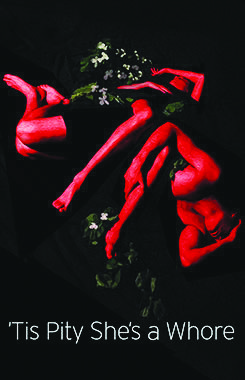
Courtesy Yale School of Drama
Rounding off a weekend filled with themes of female empowerment with Women’s Marches across the country, the Yale School of Drama is making its own impact at the University Theatre.
“’Tis Pity She’s a Whore,” a production written by John Ford and directed by Jesse Rasmussen DRA ’17, will explore the incestuous relationship between siblings Giovanni and Annabella as they pit themselves against family, society and God in the name of love.
The original ’Tis Pity, a Jacobean tragedy originally written between 1629 and 1630, was set in Parma, an oppressive society dictated by the church and money. This adaptation will take place in an imaginary future through which Rasmussen hopes to emphasize the power of the female characters, specifically Annabella, by giving the production a feminist backbone.
“You look at this play and you see the history of Western misogyny and art. You’re looking at the architecture of it and that’s built into the bones of this play,” Rasmussen said. “As a modern woman, it’s a really fascinating thing to encounter. What can we say about this awful little world and how can we connect it to the world that we’re living in?”
The work puzzled critics even during Ford’s time for its sympathetic portrayal of incest. Rasmussen said that while she does not think Ford supported incest, he did leave audiences questioning whether turning inward or turning to family is the best alternative in a selfish society. She explained that the story’s brutal setting is one of the possible reasons that the siblings are drawn to each other.
Brontë England-Nelson DRA ’17, who plays Annabella, said that mirroring each other’s mannerisms was one method for the actors to convey that they were siblings as well as lovers.
Though ’Tis Pity is usually a three hour production, this adaptation cuts down an hour and a half of dialogue, focusing instead on physical and dialogue-free sequences. Additionally, Rasmussen changed the play’s ending to better reflect the roles of the female characters within the play.
What remained unchanged, however, was the focus on abuse and violence against women.
“I think I was also really struck by the extreme violence visited on the bodies of women in this play,” Rasmussen said. “I found it highly disturbing and way too resonant for the times we live in. I think we sometimes need to see the ugliest sides of our selves put onstage to actually see what we are capable of. Ideally, it can be cleansing in some ways, not that you can get rid of it, but face up to what lives inside of many of us.”
Similarly, Edmund Donovan DRA ’17, the actor who plays Giovanni, said that his character might have fallen in love with Annabella because she represents a “saint-like figure” within corrupt Parma. He added that throughout the play, his character evolves from a pure, lovestruck boy to a “jealous and violent” figure representative of his society.
Rick Sordelet, fight director at the Yale Rep and the School of Drama, worked closely with the actors to choreograph the fight scenes. After these often emotionally and physically intense scenes, actors were encouraged to “cool down” using several techniques taught by the school, including fetal position and rocking. Additionally, actors would use methods such as the Grotowski cat exercise, a physical activity that engages many difference muscles in the body, to prepare for aggressive scenes.
“During the domestic violence scene, there’s a lot of room for spontaneity,” England-Nelson said. “We have our marked moments of ‘knife on skin’ that are choreographed. [Sordelet] sets it up so that there’s a lot of implicit movement within the choreography. It’s a balance between the brazenness of [spontaneity] and the safety of choreography.”
England-Nelson said that the various women involved in all levels of production and management, including the dramaturg, director, stage manager and design team, had a large amount of creative control over the project. She added that this fact often made her feel comfortable even during scenes when she was the subject of abuse, because the scenes had been discussed and crafted thoroughly by the females involved.
When it came to constructing costumes for the characters, costume designer Sarah Woodham DRA ’18 often found her herself finding subtle ways to imply the patriarchal setting in which the play takes place. She said she had female characters wear metal chokers to evoke male ownership of women. Additionally, she hoped to convey the characters’ roles clearly by crafting clear silhouettes and color palettes.
Woodham’s inspiration for the costume designs came from the novel “The Handmaid’s Tale.” In the story, women don red clothing, representing their “fertility, passion and lust” according to Woodham. In line with this image, she created green clothing for Annabella’s suitors, a metaphor for their envy towards one another and of their suitors’ wealth. Additionally, black was used to represent the utilitarian and traditional rule of authority figures.
“[Annabella and Giovanni] are symptomatic of their society,” Rasmussen said. “I don’t think Ford was promoting incest, but I like to think he fell in love with them while he was writing them.”
During the production, audience members will sit onstage with the actors within the University Theatre.







